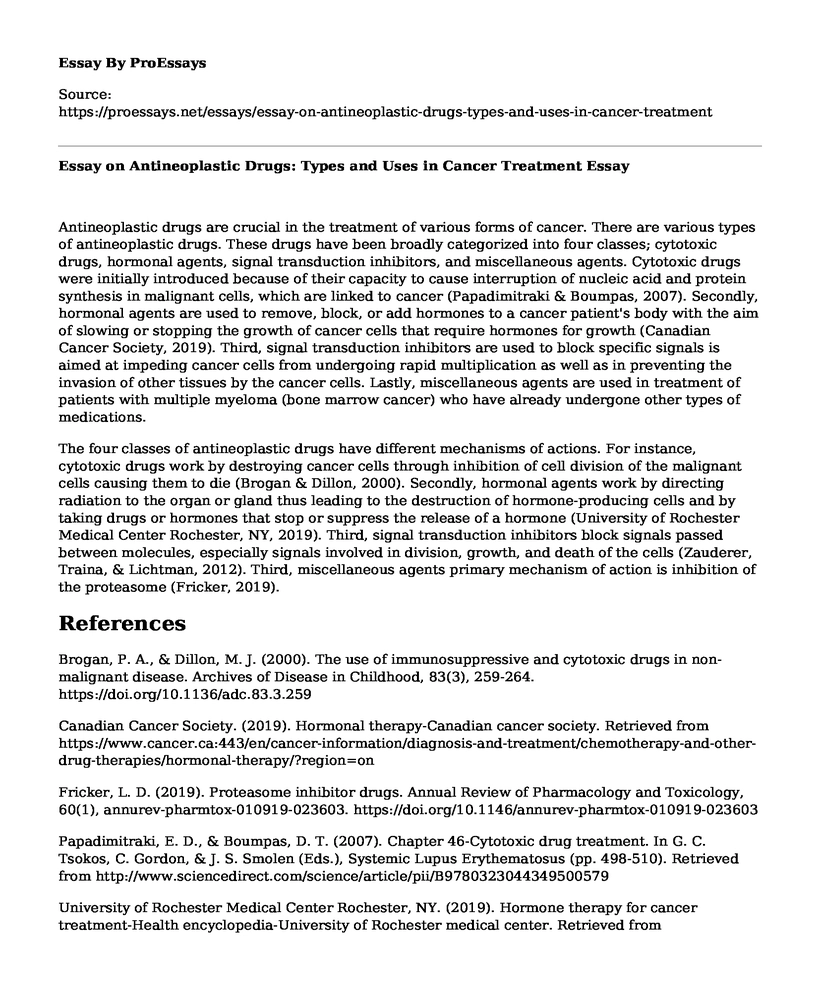Antineoplastic drugs are crucial in the treatment of various forms of cancer. There are various types of antineoplastic drugs. These drugs have been broadly categorized into four classes; cytotoxic drugs, hormonal agents, signal transduction inhibitors, and miscellaneous agents. Cytotoxic drugs were initially introduced because of their capacity to cause interruption of nucleic acid and protein synthesis in malignant cells, which are linked to cancer (Papadimitraki & Boumpas, 2007). Secondly, hormonal agents are used to remove, block, or add hormones to a cancer patient's body with the aim of slowing or stopping the growth of cancer cells that require hormones for growth (Canadian Cancer Society, 2019). Third, signal transduction inhibitors are used to block specific signals is aimed at impeding cancer cells from undergoing rapid multiplication as well as in preventing the invasion of other tissues by the cancer cells. Lastly, miscellaneous agents are used in treatment of patients with multiple myeloma (bone marrow cancer) who have already undergone other types of medications.
The four classes of antineoplastic drugs have different mechanisms of actions. For instance, cytotoxic drugs work by destroying cancer cells through inhibition of cell division of the malignant cells causing them to die (Brogan & Dillon, 2000). Secondly, hormonal agents work by directing radiation to the organ or gland thus leading to the destruction of hormone-producing cells and by taking drugs or hormones that stop or suppress the release of a hormone (University of Rochester Medical Center Rochester, NY, 2019). Third, signal transduction inhibitors block signals passed between molecules, especially signals involved in division, growth, and death of the cells (Zauderer, Traina, & Lichtman, 2012). Third, miscellaneous agents primary mechanism of action is inhibition of the proteasome (Fricker, 2019).
References
Brogan, P. A., & Dillon, M. J. (2000). The use of immunosuppressive and cytotoxic drugs in non-malignant disease. Archives of Disease in Childhood, 83(3), 259-264. https://doi.org/10.1136/adc.83.3.259
Canadian Cancer Society. (2019). Hormonal therapy-Canadian cancer society. Retrieved from https://www.cancer.ca:443/en/cancer-information/diagnosis-and-treatment/chemotherapy-and-other-drug-therapies/hormonal-therapy/?region=on
Fricker, L. D. (2019). Proteasome inhibitor drugs. Annual Review of Pharmacology and Toxicology, 60(1), annurev-pharmtox-010919-023603. https://doi.org/10.1146/annurev-pharmtox-010919-023603
Papadimitraki, E. D., & Boumpas, D. T. (2007). Chapter 46-Cytotoxic drug treatment. In G. C. Tsokos, C. Gordon, & J. S. Smolen (Eds.), Systemic Lupus Erythematosus (pp. 498-510). Retrieved from http://www.sciencedirect.com/science/article/pii/B9780323044349500579
University of Rochester Medical Center Rochester, NY. (2019). Hormone therapy for cancer treatment-Health encyclopedia-University of Rochester medical center. Retrieved from https://www.urmc.rochester.edu/encyclopedia/content.aspx?contenttypeid=85&contentid=p07236
Zauderer, M. G., Traina, T. A., & Lichtman, S. M. (2012). Novel and Targeted Therapies. In Management of Cancer in the Older Patient (pp. 95-101). WB Saunders.
Cite this page
Essay on Antineoplastic Drugs: Types and Uses in Cancer Treatment. (2023, Feb 11). Retrieved from https://proessays.net/essays/essay-on-antineoplastic-drugs-types-and-uses-in-cancer-treatment
If you are the original author of this essay and no longer wish to have it published on the ProEssays website, please click below to request its removal:
- Paper Sample on The Lives of Children and the Conscience of a Nation
- STI in Teenagers in the State of Hawaii Essay
- Argumentative Essay Sample on Abortion and Health
- Essay Example on Can Diet Strengthen Immune System & Prevent Illness?
- Essay on 125,000+ Infected, 4,600+ Dead: Preparing for the Global COVID-19 Crisis
- Brain Tumors: Cancerous, Noncancerous, Malignant, Benign - Essay Sample
- Essay Example on ACOs: Cost-Effective Solutions for Quality Healthcare







